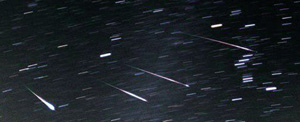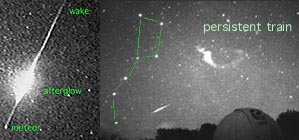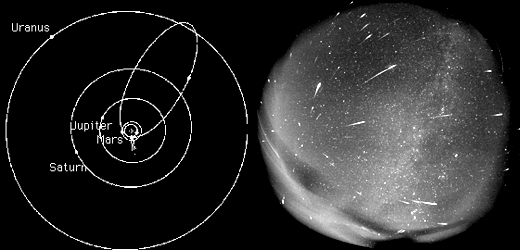|
Background facts on
meteors and meteor showers.
 Figure 1: Example of four bright Leonid meteors that
were photographed in the constellations of Monoceros
and Orion by
Lorenzo Lovato
of Italy on November 17, 1998.
Figure 1: Example of four bright Leonid meteors that
were photographed in the constellations of Monoceros
and Orion by
Lorenzo Lovato
of Italy on November 17, 1998.
METEORS: Meteors are better known as "shooting stars": startling streaks of light that suddenly appear in the sky when a dust particle from outer space evaporates high in the Earth's atmosphere.
We call the light phenomenon in the atmosphere a "meteor", while the dust particle is called a "meteoroid".
- Size:
Most visible Leonids are between 1 mm and 1 cm in diameter. For example, a
Leonid meteor of magnitude +5, which is barely visible with the naked eye in a dark sky,
is caused by a meteoroid of 0.5 mm in diameter and weights only 0.00006 gram.
-
Speed
That tiny particle can cause a light so bright that it can be seen over distances of hundreds of kilometers.
The reason is the astronomical speed of the meteoroids. Just before they enter the Earth's atmosphere,
Leonid meteoroids travel at 71 kilometers per second, or some 2,663 times as fast as a fast pitch in baseball,
or, if you want, around the Earth in 3.8 minutes!
-
Source of light
When meteoroids enter the Earth's atmosphere, they collide with numerous air molecules.
Those collisions sputter away the outer layers of the particle, creating a vapor of
sodium, iron and magnesium atoms. In subsequent collisions, electrons are knocked into
orbits at larger mean distances from the nucleus of the atoms. When the electrons fall
back to their rest positions, light is emitted. This is the same process as in gas discharge
lamps.

-
Colors of meteors
The color of many Leonids is caused by light emitted from metal atoms from the meteoroid (blue, green, and yellow) and light emitted by atoms and molecules of the air (red). The metal atoms emit light much like in our sodium discharge lamps:
sodium (Na) atoms give an orange-yellow light, iron (Fe) atoms a yellow light, magnesium (Mg) a blue-green light,
ionized calcium (Ca+) atoms may add a violet hue, while molecules of atmospheric nitrogen (N2) and oxygen atoms (O) give a red light. The meteor color depends on whether the metal atom emissions or the air plasma emissions dominate.
-
Sounds
Meteors do not normally cause audible sounds. Hence, they will pass by unnoticed if not seen. But watch out for
hissing sounds that have been reported for very bright meteors. These sounds are thought to be due to very low
frequency (VLF) radio waves interacting with the local environment.
A sonic boom is sometimes heard for very bright Leonid meteors, called fireballs,
that appear near your own observing site high in the sky.
If the particle is larger than the mean free
path of the air molecules, a high Mach number
shock wave forms in front of the meteoroid. Very rarely, this shock wave
penetrates deep enough
in the atmosphere that it can be heard.
It sounds like the sonic boom of an airplane, but as a distant rumble.
 Figure 2: The left image shows a bright afterglow in the path of a meteor
while the meteor itself is seen to move onward. Video frame from the 04:00:29 UT fireball
by Peter Jenniskens. The right image shows a persistent train high in the sky above an
observatory dome minutes after the meteor itself has faded. The train enables telescopes
to point at the path of a meteor. This train was photographed by the Uma team of the
Observatori Astronomic de Mallorca, Spain.
Figure 2: The left image shows a bright afterglow in the path of a meteor
while the meteor itself is seen to move onward. Video frame from the 04:00:29 UT fireball
by Peter Jenniskens. The right image shows a persistent train high in the sky above an
observatory dome minutes after the meteor itself has faded. The train enables telescopes
to point at the path of a meteor. This train was photographed by the Uma team of the
Observatori Astronomic de Mallorca, Spain.
PERSISTENT EMISSIONS:
Bright meteors leave persistent glows.
- Wake is the brief glow behind the
meteor head. The wake is caused mainly by the green light of neutral oxygen
atoms. Wakes last 1-10 seconds. Sometimes the term wake is also used to describe the area
directly behind the meteor head.
-
Afterglow is the persistent metalic atom (Na, Fe,Mg) emission glow in the path of bright fireballs. The afterglow lasts a few seconds.
- Persistent train is the long enduring emission that
remains in the path of a bright fireball once the afterglow has faded. Persistent trains
can last for 1-30 minutes (typically 4-6 minutes) at an apparent brightness
of +4 to +5 magnitude. The optical light of these long enduring trains
is from Na (sodium) and FeO (iron oxyde),
from airglow-type chemistry of the recombination of oxygen atoms and ozone molecules
that is catalised by sodium and iron atoms.
Persistent trains last long enough to enable telescopic studies of the path of a meteor.
Upper atmosphere winds distort the shape of the train.
 Figure 3: The nucleus of comet 1P/Halley, showing jets of water vapor and
dust sprouting away.
Figure 3: The nucleus of comet 1P/Halley, showing jets of water vapor and
dust sprouting away.
WHERE DO METEORS COME FROM:
Meteoroid streams are caused by the debris of comets.
The stuff of comets comes from interstellar space where the materials
are assembled in the atmospheres of stars and in the
dense molecular clouds of gas and dust between the
stars. The comets are build of that material and
were formed in the outer parts of the solar system,
in regions beyond Saturn's orbit, at the time of the birth of our solar
system.
- How meteoroids leave the comet is a matter
of research. When comets approach the Sun, the ices evaporate and
the dust particles are ejected into orbit in geyser like fountains.
- Comet nucleus is the mountain of ice and dust
(mostly dust) that is at the center of a comet. This picture is the nucleus of comet
1P/Halley. The nucleus of this comet was
photographed by the Giotto Satellite in 1986.
It has a 2-3 times larger nucleus than 55P/Tempel-Tuttle.
- Comet 55P/Tempel-Tuttle
is the parent of the Leonid meteoroid stream. The orbit is shown in the graph above.

Figure 4: The orbit of comet 55P Tempel-Tuttle in a diagram by Yeomans et al.
(1996). The planet positions are shown
for February 28, 1998, when the comet passed the Sun most
recently. The comet travels every 33.3 years between the orbits of Earth and Uranus. Right
shows an all-sky view of the Leonid outburst from Modra Observatory in a 4 hour exposure
on November 17, 1998.
 Figure 5: A classical picture of a comet, showing the dust and gas tail. The
dust trail in the comet orbit is indicated.
Figure 5: A classical picture of a comet, showing the dust and gas tail. The
dust trail in the comet orbit is indicated.
METEOR SHOWER:
Some days of the year show a larger number of meteors than usual that all have
a common point of origin on the sky and originate from the same comet.
The Leonids are such a meteor shower.
METEOROID STREAM: is the cloud of dust particles in
the path of a comet. When Earth encounters a meteoroid stream, the particles evaporate
high in the atmosphere in a brilliant light, causing a meteor shower.
- Radiant is the point in the sky from where all meteors
seem to radiate.
The radiant of the Leonids is in the constellation Leo. The radiant is a perspective effect.
All particles move in about the same orbit (roughly that of the comet).
An observer in the middle of the stream sees the meteors fall left
and right, above and behind him.
However, they all seem to come from a certain direction. That direction is the radiant.
- Dust trail is what the astronomers call the young
meteoroid stream. The dust trail is found spread out along the orbit of the comet (as
illustrated in picture of comet to the left).
- Dust tail of a comet
is caused by dust particles small
enough to scatter sunlight. Those are very small smoke-like particles (less than 0.1 mm
in size) and are ejected from the dust coma by solar radiation forces.
- Gas tail of a comet is what is left over from the
evaporating ice. The gas molecules ionize and move along the magnetic field lines rapidly
away from the comet, in opposite direction from the Sun
- Dust trails and dust tails represent large and small
dust particles, respectively.
The large particles remain close to the comet and form a dust
coma. However,
small ejection velocities cause large differences in orbital period of these particles.
Hence, in the next return the slow particles
will lag and the fast particles will proceed the comet. The result is a trail like structure
in the orbit of the comet. We see a meteor storm when the Earth crosses that
trail of dust.
- Meteor storm is seen when Earth crosses such dust trail. Officially, for a meteor storm rates have to increase to 1000 per hour, or 1 per second.
- Annual shower is the name for a wider and more
dispersed meteoroid stream after the major planets perturbed the dust away from the
dust trails. Earth encounters this dust at about the same intensity every year.
In most years, the Leonids are a rather insignificant
annual meteor shower. Rates peak at 13 per hour on November 17. The main activity is between November 13 and 20, but rates are larger than
1 per hour in the period
between October 31 and November 30 (in good dark skies early in the morning).
- Meteor outburst is the common name for meteor
storms and lesser non-annual showers.
Only when the Earth travels through relatively fresh cometary matter will rates go up significantly
above the normal level of annual activity. Then, and only then, can we see a meteor outburst. The Leonid storms
are such meteor outbursts. There were no Leonid outbursts reported between 1970 and 1993. The first Leonid outburst
of a new series associated with the upcoming return of P/Tempel-Tuttle was
seen in 1994.
|


 Figure 2: The left image shows a bright afterglow in the path of a meteor
while the meteor itself is seen to move onward. Video frame from the 04:00:29 UT fireball
by Peter Jenniskens. The right image shows a persistent train high in the sky above an
observatory dome minutes after the meteor itself has faded. The train enables telescopes
to point at the path of a meteor. This train was photographed by the Uma team of the
Figure 2: The left image shows a bright afterglow in the path of a meteor
while the meteor itself is seen to move onward. Video frame from the 04:00:29 UT fireball
by Peter Jenniskens. The right image shows a persistent train high in the sky above an
observatory dome minutes after the meteor itself has faded. The train enables telescopes
to point at the path of a meteor. This train was photographed by the Uma team of the  Figure 3: The nucleus of comet 1P/Halley, showing jets of water vapor and
dust sprouting away.
Figure 3: The nucleus of comet 1P/Halley, showing jets of water vapor and
dust sprouting away.

 Figure 5: A classical picture of a comet, showing the dust and gas tail. The
dust trail in the comet orbit is indicated.
Figure 5: A classical picture of a comet, showing the dust and gas tail. The
dust trail in the comet orbit is indicated.
